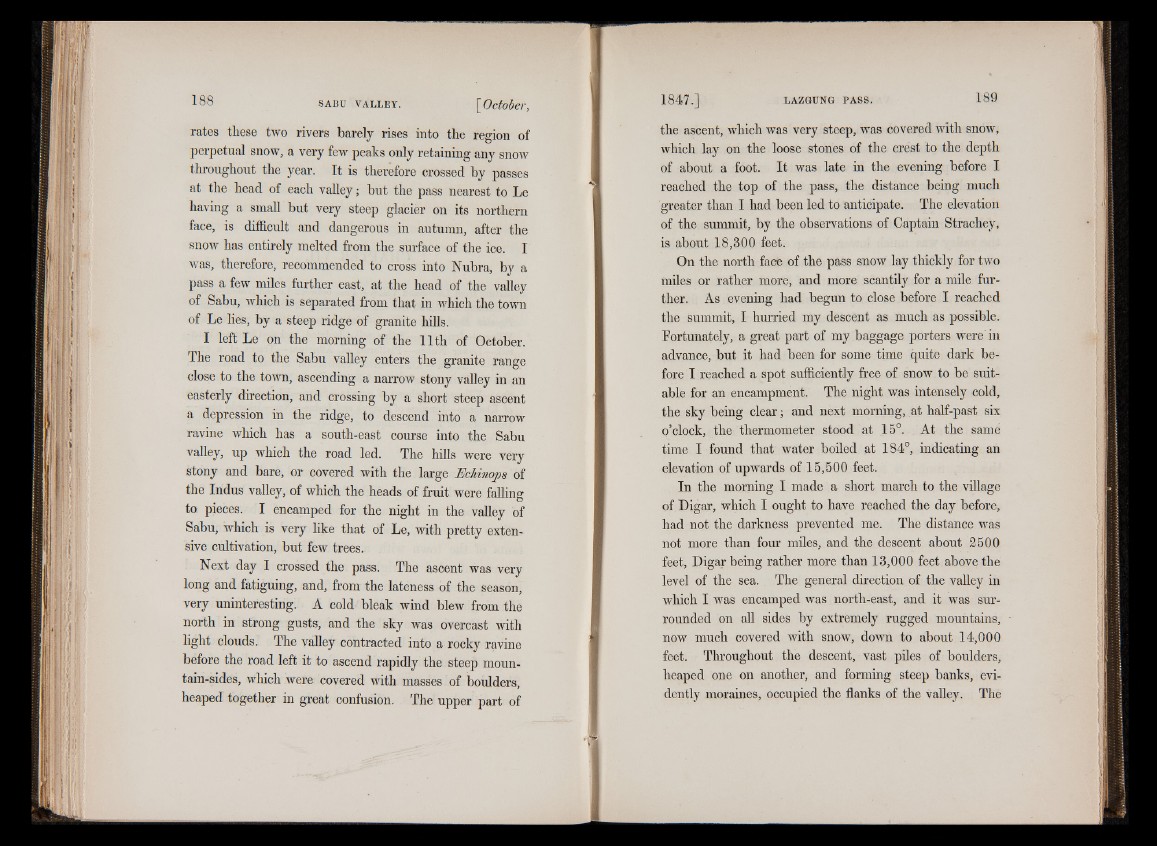
rates these two rivers barely rises into the region of
perpetual snow, a very few peaks only retaining any snow
throughout the year. It is therefore crossed by passes
at the head of each valley • but the pass nearest to Le
having a small but very steep glacier on its northern
face, is difficult and dangerous in autumn, after the
snow has entirely melted from the surface of the ice. I
was, therefore, recommended to cross into Nubra, by a
pass a few miles further east, at the head of the valley
of Sabu, which is separated from that in which the town
of Le lies, by a steep ridge of granite hills.
I left Le on the morning of the 11th of October.
The road to the Sabu valley enters the granite range
close to the town, ascending a narrow stony valley in an
easterly direction, and crossing by a short steep ascent
a depression in the ridge, to descend into a narrow
ravine which has a south-east course into the Sabu
valley, up which the road led. The hills were very
stony and bare, or covered with the large JEcUnops of
the Indus valley, of which the heads of fruit were falling
to pieces. I encamped for the night in the valley of
Sabu, which is very like that of Le, with pretty extensive
cultivation, but few trees.
Next day I crossed the pass. The ascent was very
long and fatiguing, and, from the lateness of the season,
very uninteresting. A cold bleak wind blew from the
north in strong gusts, and the sky was overcast with
light clouds. The valley contracted into a rocky ravine
before the road left it to ascend rapidly the steep moun-
tain-sides, which were covered with masses of boulders,
heaped together in great confusion. The upper part of
the ascent, which was very steep, was covered with snow,
which lay on the loose stones of the crest to the depth
of about a foot. It was late in the evening before I
reached the top of the pass, the distance being much
greater than I had been led to anticipate. The elevation
of the summit, by the observations of Captain Strachey,
is about 18,300 feet.
On the north face of the pass snow lay thickly for two
miles or rather more, and more scantily for a mile further.
As evening had begun to close before I reached
the summit, I hurried my descent as much as possible.
Fortunately, a great part of my baggage porters were' in
advance, but it had been for some time quite dark before
I reached a spot sufficiently free of snow to be suitable
for an encampment. The night was intensely cold,
the sky being clear; and next morning, at half-past six
o’clock, the thermometer stood at 15°. At the same
time I found that water boiled at 184°, indicating an
elevation of upwards of 15,500 feet.
In the morning I made a short march to the village
of Digar, which I ought to have reached the day before,
had not the darkness prevented me. The distance was
not more than four miles, and the descent about 2500
feet, Digar being rather more than 13,000 feet above the
level of the sea. The general direction of the valley in
which I was encamped was north-east, and it was surrounded
on all sides by extremely rugged mountains,
now much covered with snow, down to about 14,000
feet. Throughout the descent, vast piles of boulders,
heaped one on another, and forming steep banks, evidently
moraines, occupied the flanks of the valley. The